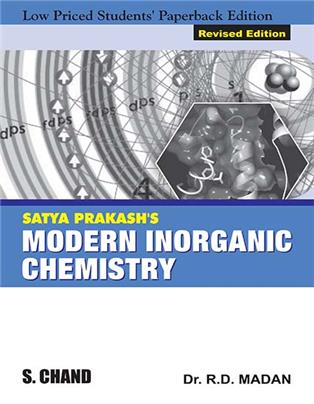
Author : Dr. R.D. Madan
Price : 850.00 680.00
Satya Prakash's Modern Inorganic Chemistry is a treatise on the chemistry of elements on the basis of latest theories of Chemistry. Initial chapters are devoted to the study of fundamentals of Chemistry such as structure of atom, periodic classification of elements, chemical bonding and radioactivity, to name a few. It further graduates to complex discussions not only on extraction, properties and uses of the elements but also on preparation, properties, uses and structure of their important compounds. Chemistry of elements and their compounds have been explained on the basis of their position in the long form of periodic table and their electronic configurations/structures. Special emphasis has been put on the
discussion of the correction between the structure and properties of elements/ compound. The book caters to the requirements of Bachelor in Science (Pass) courses. With detailed discussion on several advanced topics, the students of Bachelor in Science (Honours) and Masters in Science would also find it extremely
useful.
1. Structure of the Atom (i)
(Quantum Mechanical Approach:
Dalton to Bohr-Sommerfeld)
2. Structure of the Atom (ii) (Wave
Mechanical Approach)
3. Modern Periodic Table and
Electronic Configuration of Atoms
4. Periodic Properties
5. Radioactivity, Isotopes, Isobars
and Isotones
6. Nuclear Transmutations and
Artificial Radioactivity
7. Chemical Bonding: Lewis Theory
8. Chemical Bonding: Orbital
Concept, 9. Structure of Solids
10. Oxidation - Reaction Reactions
11. Standard Electrode Potentials
12. Modern Concepts of Acids and
Bases
13. Non-Aqueous Solvents
14. Principles and Processes of
Metallurgy
15. Various Reactive forms and
Isotopes of Hydrogen
16. General Study of Hydrides
17. Heavy Water (D2O)
18. General Characteristics of Group
1 (IA) Elements: Alkali Meals
19. Chemistry of Lithium and its
Compounds
20. General Characteristic of Group
2 (IIA) Elements: Alkaline Earth
Metals
21. Chemistry of Beryllium, Radium,
their Compounds and Portland
Cement
22. General Characteristic of Group
13 (IIIA) Elements: Boron Group
Elements
23. Chemistry of Group 13 (IIIA)
Elements, their Compounds and
Ceramics Industry
24. Hydrides of Boron: Boranes
25. General Characteristics of Group
14 (IVA) Elements: Carbon
Group Elements
26. Compounds of Carbon
27. Carbides
28. Metallic Carbonyls
29. Compounds of Silicon and Glass
Industry
30. General Characteristics of Group
15 (VA) Elements: Nitrogen
Group Elements
31. Fertilisers
32. Hydrides, Oxidesand Oxy Acids
of Nitrogen
33. Nitrides
34. Oxides, Oxy acids, Halides and
Oxyhalides of Phosphorus
35. General Characteristics of Group
16 (VIA) Elements: Oxygen
Group Elements
36. Oxides, Oxy acids, Halides and
Oxyhalides of Sulphur
37. General Characteristics of Group
17 (VII A) Elements: Halogens
38. Fluorine and Fluorocarbons,
39. Halogen Acids: Hydracids or
Hydrogen Halides
40. Binary Halogen - Oxygen
Compounds and Oxyacids of
Halogens
41. Interhalogen Compounds,
Polyhalides and Pseudohalogens
42. Elements of Group 18 (Zero):
Noble Gases
43. Coordination Compounds
44. Characteristics of d-Block
Elements (Transition and Inner-
Transition Elements)
45. Group Discussion of d-Block
Elements
46. Extraction, Properties and uses
of Some d-and f-Block Elements
47. Some Compounds of d-and-f
Block Elements
• Subject
• Index
• Strong pedagogy comprising more than 400 questions with explanations and
answers, apt number of numerical questions with solutions and nearly 1000
university questions, to provide the students with better implied understanding
of the concepts and to test their level of learning. Typical conceptual questions
with answers and detailed solutions at the chapter end covering all important
concepts, reaction equations, mechanisms and principles.
• Close to 500 diagrams and more than 60 tables interspersed throughout the text make it lucid and facilitate the grasping of concepts in an easy manner.
• Detailed subject index for quick cross-reference and detailed contents.
Be the first one to review
Your email address will not be published.
Your rating for this book :
S Chand And Company Limited
Building No. D-92, Fifth Floor,
Sector – 02, Noida 201301,
Uttar Pradesh (India)
1800 1031 926